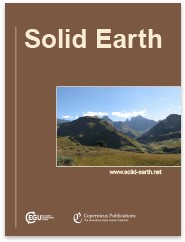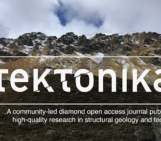

Fabrizio Storti
The third blog for TS is an invited guest blog by Fabrizio Storti, the chief executive editor of the EGU journal Solid Earth. Solid Earth publishes open access manuscripts on the composition, structure, and dynamics of the Earth from the surface to the deep interior. It is the journal for our community and we encourage everyone to see if they can contribute a manuscript and/or participate in the open review process. This blog is also posted by other divisions working on solid earth themes.
Open access publishing in Solid Earth

The importance of publishing open access is increasing every year in Scientific Institutions worldwide and is becoming mandatory in several research funding
programmes. Many funding institutions, including ERC, are financially supporting publishing in open access journals. EGU and Copernicus launched open access publishing in 2001, well before other publishers, and this means that we have accumulated a lot of experience with making articles available open access. But not only our journals are open access, we also have a fully open, interactive review system.
Without entering into details, which are available in the EGU portal (http://www.egu.eu/publications/open-access-journals/), the major diagnostic features are the following:
– As soon as a manuscript is submitted, it undergoes a preliminary assessment by the relevant Executive Editor and, if found suitable for possible publication, a Topical Editor is assigned to immediately start the review process. At this stage the manuscript receives a DOI and can be cited as published in the Discussion version of the journal (the non-peer review journal).
– The review process is open, so reviewers upload their reports in the public domain, as well as authors do with their rebuttal letters. Everybody can download manuscripts under review and upload comments, which will help authors improve their manuscripts.
Solid Earth (SE: http://www.solid-earth.net/) is the EGU open access journal in the broad area of Earth system sciences: http://www.solid-earth.net/about/aims_and_scope.html. The journal is organized into six topical clusters (http://www.solid-earth.net/), each one handled by an Executive Editor. Different types of manuscripts can be submitted: http://www.solid-earth.net/about/manuscript_types.html, including special issues, pending approval of proposals by Executive Editors.
EGU is a bottom-up union that relies on the fundamental contributions by members to organize events, first of all the Annual General Assembly.
The same approach has allowed several EGU journals to become leaders in their fields. Solid Earth is still young and, as such, it has a great potential of growing up to get established as one of the best journals in Earth system sciences. With your contribution, the journal impact factor, higher than 2.0, can significantly increase and start a virtuous loop to attract more and more good papers.
Please take few minutes of your time to browse the journal homepage (http://www.solid-earth.net/), sign in to get alerts and enjoy published papers, and think about submitting a manuscript. We are all volunteers in EGU and by supporting the self-managed, non-profit Solid Earth journal, all together we can make it one of the reference journals in Earth system sciences.
Looking forward to handle your manuscripts!
Best regards,
SE Editorial Team.



Pingback: Tectonics and Structural Geology | Publishing in Solid Earth: interview with Anna Rogowitz
Pingback: Tectonics and Structural Geology | Introducing the people behind the TS division